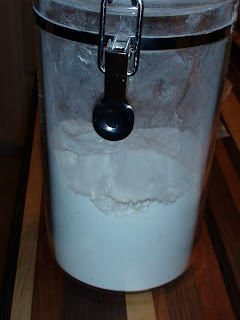Clarified butter results when you separate the milk fats from the butter. In a home kitchen, you can do this by place butter in a double boiler and allowing it to separate. As with chocolate, do not boil it. This will ruin the separation process and you will not receive the desired outcome.
As the butter separates, the milk fats float to the top and you skim them off. Then you strain the remaining butter to ensure all milk fat particles are removed and VIOLA you have clarified butter! Idea for amounts... if you want 5 lbs of clarified butter - start with 6 lbs. regular unsalted butter.
 Clarified butter is often used to make roux, soups and sauces. It can be stored at room temperature for 30 days or in the refrigerator indefinitely.
Clarified butter is often used to make roux, soups and sauces. It can be stored at room temperature for 30 days or in the refrigerator indefinitely.Roux is a mixture of flour and clarified butter* (or oil or other fats) used to thicken soups, stews and sauces. The make up of roux is typically a 1:1 ratio. For a roux to reach it's full flavor and aroma, you need to simmer it for 10 - 20 minutes to a temperature around 160 degrees F (170 degrees F) at the highest. You heat the butter/oil first. Add just a small amount of flour to see if it generates some bubbles in the butter/oil and if it does, whisk in the rest of the flour. It is okay to simmer, but do not boil as noted below.
Clarified butter is preferred over regular butter because it doesn't burn. However, if you do not have the time to make clarified butter, I've found that you can still use regular butter for roux at home. Granted, you must keep a close eye on it to make sure you don't burn it.

White Roux: roux that just cooks the flour (~5 minutes) - stays relatively white and does not taste or smell 'nutty' like the blonde and brown roux. It also can have a gritty texture to it. It can be used in a milk based sauce, like a bechamel sauce, or a clam chowder. Our instructor says he almost always uses blonde roux, even in bechamel, because he doesn't like the texture, smell and taste of white roux.
Blonde Roux: roux that is cooked for ~ 20 minutes until it achieves a golden color and a 'nutty' aroma.
Brown Roux: roux that is cooked for ~ 35 minutes until it achieves a light brown color. It has a stronger aroma than a blonde roux, but does not thicken as well because the extended cooking time weakens the flour. Dark brown roux is cooked for ~45 minutes and is used more for flavor than thickening. Brown roux's are common in gumbo.
In general, the darker the roux, the stronger the flavor and the weaker the thickening power.
This is an example of a blonde roux, which we later used in a sauce. 
This is an example of a roux that I accidentally let boil and as you can see the butter and flour separated. So sad!!
I showed the two photos because our chef indicated that you can 'break' a roux if you heat it over 180 degrees F. 
This is an example of a roux that I accidentally let boil and as you can see the butter and flour separated. So sad!!

More to come on roux's, soups, and sauces...
1 comment:
They actually sell clarified butter over here (or ghee) in the same giant metal containers we buy olive oil in at home! Funny! =) I would bring some back for you...but I do not think customs would let me in!
Post a Comment